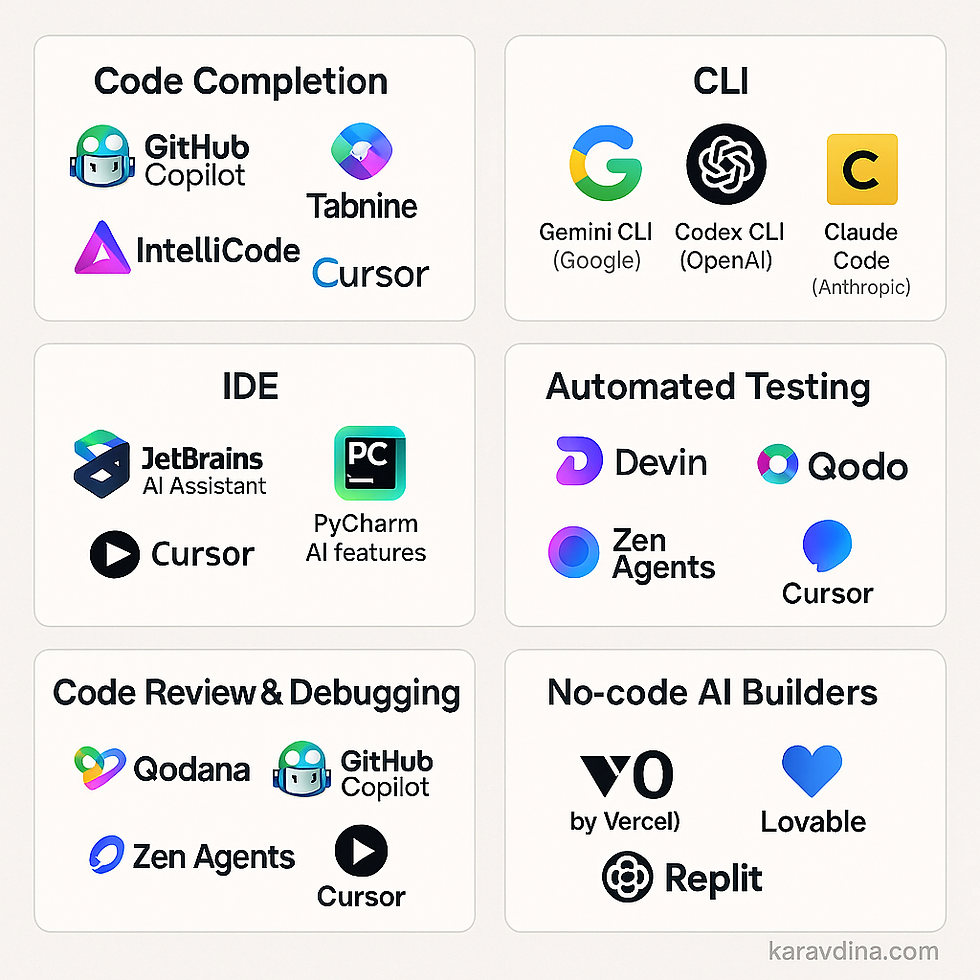AI coding toolS: Which one do you need?
- Anastasia Karavdina
- Sep 14
- 2 min read

If there’s one place where AI is already making a big impact, it’s AI Coding. This is one of the fastest-growing fields in tech, generating increasing revenue and bringing forward players that hardly anyone had heard of just a few years ago.
If you haven’t tried an AI coding assistant yet, I strongly recommend giving one a go. The challenge, though, is choosing the right tool in what has quickly become a crowded ecosystem.
Broadly speaking, most AI coding assistants can be grouped into five main categories, based on how they fit into your workflow:
Code Completion
These tools suggest the next line or block of code based on the current context. They were the first widely adopted form of AI coding assistance. Today, while they’re still useful, they can sometimes feel less impressive or even a bit distracting if not well tuned.
Examples: GitHub Copilot, Tabnine
CLI (Command-Line Interface)
Assistants you run directly in the terminal. They’re great if you prefer working with text commands and want AI included directly into your CLI workflow.
Examples: Gemini CLI, Claude Code
IDE (Integrated Development Environment) Tools
Here, AI is built right into the editor you already use. Instead of switching between tools, you can write, debug, refactor, and even document code seamlessly inside your IDE.
Examples: Cursor, JetBrains AI Assistant
Code Review & Debugging
These tools automatically catch bugs, explain errors, and suggest fixes, often before you even notice something’s wrong. They’re also increasingly used in CI/CD pipelines.
Examples: DeepCode (Snyk), CodiumAI, Devin
Low-code / No-code AI Builders
Built for non-developers or product folks, these tools let you create applications via natural language, drag-and-drop, or high-level prompts. They’re particularly handy for quickly building prototypes or testing frontend ideas.
Examples: v0 (by Vercel), Lovable, Replit, Base44
Each group has its own strengths, and the best choice really depends on your habits and goals:
If you spend most of your time inside an IDE, AI-powered IDE tools may feel the most natural. Cursor stands out here: it combines the familiar VS Code environment with AI coding agents, lets you pick the LLM you want, or even switch to an “Auto” mode where it chooses the model for you.
If you’re more of a terminal-first developer, CLI tools might be the better fit. Claude Code is one of the most popular here, with a strong reputation for usability and power.
If you’re a PM or PO without coding experience, low-code/no-code builders are a game-changer, making it possible to spin up prototypes, especially frontends and UIs, without writing a single line of code.
👉 Bottom line: AI coding assistants are no longer an experiment. They’re becoming essential. The real question is not if you’ll use one, but which one fits your workflow best.
Here is quite nice overview of the existing tools with tips&tricks 8-)



Comments